Abstract
Increasing infrastructure growth has forced the construction industry to look for wasteful, cheap, and suitable materials for construction. An investigation into the geotechnical utilization of fly ash was carried out in the present study. Practical applications normally involve the use of large quantities of fly ash, so proper mixing of the fly ash with other materials may not be significantly achieved. Therefore, the present paper investigates the behaviour of a fly ash–bentonite layered system with different ratios. The physical properties and chemical composition of fly ash and bentonite were determined. SEM and energy dispersive X-ray experiments were also used to investigate the morphology and phase compositions of fly ash and bentonite. A series of consolidated undrained (CU) triaxial tests on fly ash–bentonite were carried out to investigate shear strength characteristics. Fly ash (F) and bentonite (B) were used in the following ratios: 1:1 (50% F:50% B), 2:1 (67% F:33% B), 3:1 (75% F:25% B), and 4:1 (80% F:20% B), with different numbers of interfaces (N), i.e., 1, 2, and 3 for each ratio. The deviator stress and cohesion value were found to increase with the number of interfaces for each ratio. The angle of shear resistance changed marginally with the increase in the fly ash–bentonite ratios and varying interfaces.
1. Introduction
Around 70–75% of the electricity is generated by coal-based thermal power plants in India. Indian coal is of poor quality and contains almost 30–45% of ash [1,2]. Fly ash is also considered a hazardous water pollutant due to the presence of toxic heavy metals [3]. According to estimates from the Fly Ash Utilization Program (FAUP), the coal supplied to thermal power plants in the amount of 686.34 million tonnes in 2020–2021, which contains a significant amount of ash, had a fly ash generation of 232.56 million tonnes in 2020–2021 [4]. The Ministry of Power, Govt. of India estimates 1800 million tonnes of coal use every year and 600 million tonnes of fly ash generated by 2031–2032. Due to persistent efforts by the Fly Ash Mission in India and some other agencies, the utilization of fly ash has improved from a meagre 3% in 1994 to 92% in 2020, which is nowhere near its target of 100% fly ash utilization [5]. Various authors have successfully stabilized expensive soil by blending it with fly ash [6,7,8]. Fly ash has also been modified with lime, gypsum, and fibre [9,10].
Bentonite is an efficient clay substance for creating low-permeability barriers. Bentonite is a valuable material because of its great plasticity, strong dry-bonding strength, high shear and compressive strength, and low permeability [11,12,13]. Many researchers have carried out experimental investigations on fly ash mixed with bentonite [14,15,16]. The suitability of fly ash as a hydraulic barrier as well as the use of bentonite were investigated to improve the geotechnical qualities of fly ash [14]. It was established that 70% by weight of fly ash can be blended with bentonite to meet the requirements of compacted landfill liners [15,17].
The permeability of the compacted fly ash deposits is moderate. Fly ash is not suitable for use in seepage barriers such as liners. To lower the permeability of fly ash, clay-like admixtures should be used [2,18]. The utilization of a large quantity of fly ash means proper mixing of the fly ash with other materials may not be significantly achieved. To overcome this problem, the layered system has been adopted in the present study. When two layers of different materials interact at their interfaces, the deformation behaviour of the composite is influenced by the inherent properties of the materials. The effect of fly ash on bentonite ratio and the number of layers was studied.
2. Materials Used
2.1. Fly Ash
The fly ash came from a national thermal power plant in Dadri, India, with an installed capacity of 800 megawatts. The plant generates about 10 million tonnes of bottom ash and 39 million tonnes of fly ash each day. The fly ash is collected in a total of 24 electrostatic precipitator hoppers. To avoid deterioration over time, fly ash was collected in dry form and stored in moisture-proof containers. The results of the research into the chemical composition and physical properties of fly ash are shown in Table 1 and Table 2, respectively. It was designated as class F, as defined by ASTM C 618 [19], indicating that it is typically obtained from bituminous and anthracite coals. The intrinsic diversity of fly ashes from different sources as well as from the same source is greater in India than in other nations such as Italy and the United States [20]. The chemical constituents of the Dadri fly ash were found to be within the range of other Indian fly ash chemical compounds. Scanning electron microscope (SEM) and Energy Dispersive X-ray (EDX) were carried out through JEOL, instrument JSM-6510 (Figure 1). The following settings were used to photograph the morphological characteristics of the fly: accelerating voltage = 15 kV, magnification = 3000, spot size = 40, µm marker = 5, and tilt = 0. The image clearly shows that fly ash is mostly made up of spherical particles of various sizes (Figure 1). Figure 2a shows the EDX of fly ash.

Table 1.
Chemical composition of fly ash.

Table 2.
Physical properties of fly ash and bentonite.
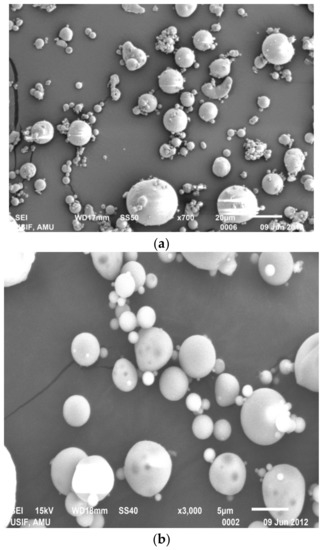
Figure 1.
Scanning electron micrographs of fly ash with different magnification factors: (a) 700; (b) 3000.
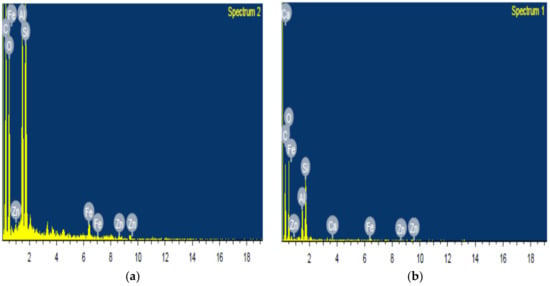
Figure 2.
Energy-dispersive X-ray spectroscopy (EDS): (a) fly ash and (b) bentonite.
The density bottle method was used to determine the specific gravity of fly ash, which was found to be 2.19 according to IS: 2720-Part 3 [21]. To assess the grain size distribution of the Dadri fly ash, a hydrometer test was performed according to Indian Standard IS 2720-Part 4 [22]. The Atterberg limits were measured according to Indian Standard IS 2720-Part 4 [23]. The liquid limit (WL) of fly ash was found to be 24% and non-plastic in nature. For typical soils, a light compaction standard Proctor test was performed according to Indian Standard IS 2720-Part 10 [24]. The optimal moisture content (OMC), unit weight, and maximum dry density (MDD) were found to be 22%, 14.39 kN/m3, and 11.8 kN/m3, respectively. Fly ashes have a lower MDD and a higher OMC than normal soils. This may be attributed to lower specific gravity and the porous nature of the particle. Unconfined compression tests were carried out in accordance with Indian Standard IS 2720-Part 10 [24]. Two specimens were tested, and at 2% axial strain, the failure axial stress was attained, causing the specimens to collapse. The Dadri fly ash specimens had an average unconfined compressive strength of 110 kN/m2. At the MDD–OMC state, specimens were prepared and a falling head permeability test was performed. The coefficient of permeability of fly ash was determined to be around 5.51 × 10−6 cm/s, which is normally in the range of non-plastic silts. Table 2 shows the physical properties of fly ash and bentonite.
2.2. Bentonite
The bentonite utilized was dry, sieved through an IS sieve of 425 microns, and stored in the laboratory in sealed containers. The bentonite’s morphological properties presented in Figure 3 were collected under the following conditions: accelerating voltage of 15 kV, 2700 magnification, 40 spot size, 5 µm marker, and tilt = 0. Energy dispersive X-ray analysis (EDS or EDX), as shown in Figure 2b, is based on the diffraction of very short-wave electromagnetic radiation in the regular, continuous mineral lattice. The specific gravity of bentonite was found to be 2.73. As illustrated in Figure 3, the particle size distribution curves of fly ash and bentonite were plotted as shown in Figure 4. The liquid limit (WL) and plastic limit (WP) of bentonite were found to be 261% and 38%, respectively. CH has been assigned to it. The compaction curves for bentonite and fly ash are shown in Figure 5. The optimum moisture content (OMC), unit weight, and maximum dry density (MDD) of bentonite were found to 28%, 21.52 kN/m3, and 16.81 kN/m3, respectively. The coefficient of permeability was found to be close to 8.52 × 10−8 cm/s.
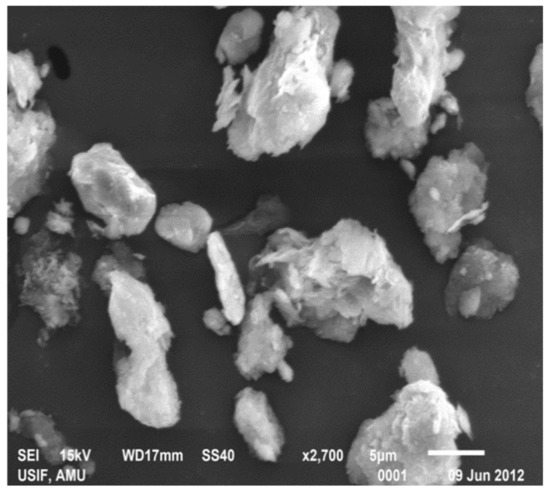
Figure 3.
Scanning electron micrographs of bentonite at 2700 magnification factor.
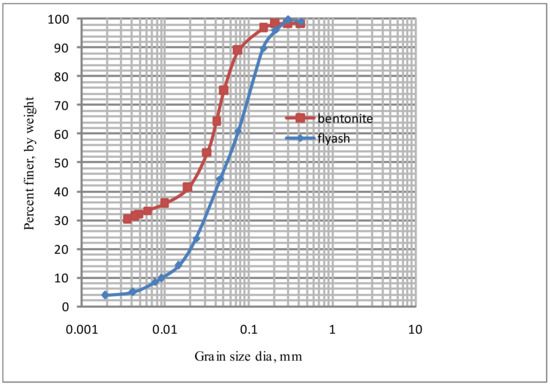
Figure 4.
Particle size distribution curves for fly ash and bentonite.
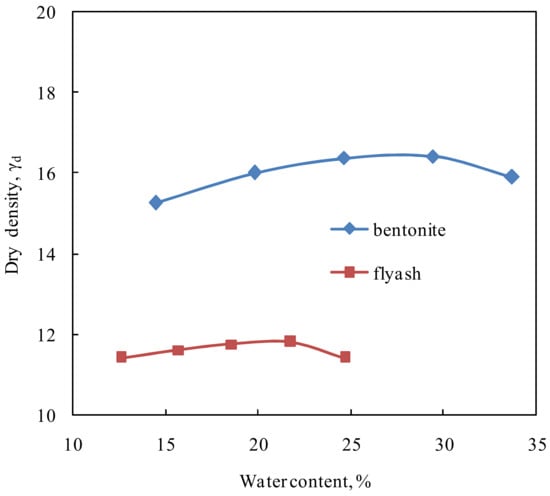
Figure 5.
Proctor compaction curve of fly ash and bentonite.
3. Experimental Programme
Laboratory tests were conducted on the cylindrical specimen having a size of 39 mm in diameter and 84 mm in length. Experimental details are described in Table 3. Fly ash and bentonite were used in the following ratios (by volume): 1:1 (50% F:50% B), 2:1 (67% F:33% B), 3:1 (75% F:25% B), and 4:1 (80% F:20% B) in two layers, three layers, and four layers (N = 1, 2, and 3). Figure 6 explains the diagram presentation for F:B = 2:1 in different layer combinations. For F:B = 2:1 in two layers, the length of the fly ash and bentonite samples was kept at 56 mm and 28 mm, respectively. For F:B = 2:1 in three layers, the length of fly ash and bentonite in each layer was taken as 28 mm. However, for F:B = 2:1 in a four-layer combination, the length of each layer of fly ash and bentonite was kept at 28 mm and 14 mm, respectively. Each test was repeated once for better accuracy, so a total of 84 samples were tested under three different confining pressures of 100 kPa, 200 kPa, and 300 kPa.

Table 3.
Experimental programme.
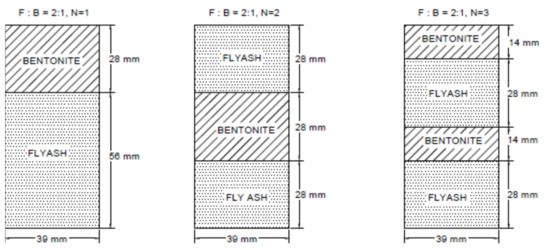
Figure 6.
Diagrams representing the layered arrangement in samples for F:B = 2:1.
3.1. Sample Preparation
Each sample was prepared on optimum moisture content. Firstly, Proctor compaction tests were carried out to find optimum moisture content and maximum dry density. The weights of the fly ash and bentonite were calculated for each layer by using max dry density of a sample 39 mm in diameter and 84 mm in length. A pre-determined amount of dry material was mixed properly by adding 28% (for bentonite) and 22% (for fly ash) water. Material was filled in a sampler at 5 mm thickness for each layer and compacted by an iron rod of diameter 20 mm of 250 gm weight to ensure effectiveness. Figure 7a–e represents a few specimens used in the present laboratory tests. The fly ash and bentonite samples are shown in Figure 7a,b. However, for F:B = 1:1 in the layer combination as N = 1, the length of each layer was taken as 42 mm, as shown in Figure 7c. For F:B = 1:1 with N = 2 and 3, the samples are shown in Figure 7d,e. To achieve homogeneity and thixotropy, the samples were left for 24 h. After that, the sample was placed in a pressure cell and exposed to a vertical compression force as well as all-around hydrostatic pressure. With end caps and rubber rings in place, the sample was correctly sealed, and the sealing rings of the cell were also properly positioned. Before testing, samples were saturated for 24 h.
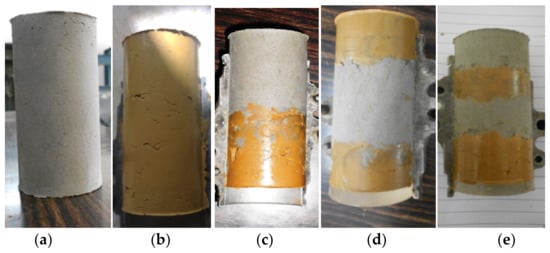
Figure 7.
Specimen before saturation of: (a) fly ash, (b) bentonite, (c) F:B = 1:1 in N = 1, (d) F:B = 1:1 in N = 2, and (e) F:B = 1:1 in N = 3.
3.2. Test Procedure
The consolidated undrained (CU) test was performed on samples (excluding simple fly ash) in which complete consolidation of the test specimen was allowed under confining pressure, but no drainage was allowed during shear. Back pressure was used to obtain full saturation. During the CU test, the effective stress parameters c and ϕ were determined by measuring the pressure in the pores.
The deviator stress and axial strain were calculated when the samples were exposed to confining pressures (σ3) of 100 kPa, 200 kPa, and 300 kPa. The data collection was totally computer controlled, and the tests were run at a constant strain rate of 2% per minute. A regulated speed driven motor with a compression force of up to 100 kN was used to impose the axial displacement. As shown in Figure 8, the linear variable differential transformer (LVDT) and pore pressure transducers (PPT) were used to measure settlement and pore water pressure of the sample, respectively. All instruments were duly calibrated before testing.
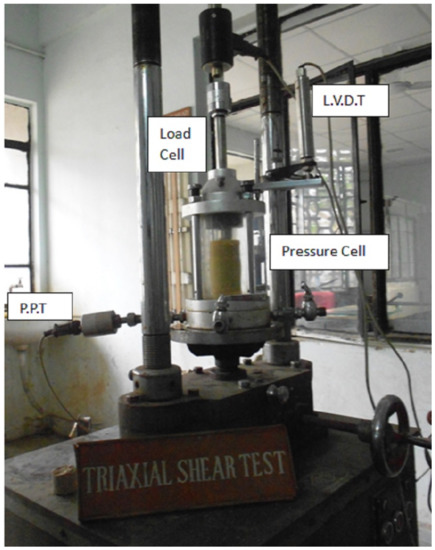
Figure 8.
Triaxial shear test apparatus with LVDT, PPT, and load cell.
4. Results and Discussion
4.1. Stress-Strain Behaviour
Figure 9 shows the response of deviator stress to axial strain at confining pressures of 100, 200, and 300 kPa. Different layered systems with varying numbers of interfaces have been studied. Apart from the different layers used, the ratio of fly ash to bentonite has been subjected to variation from 1:1 to 4:1. Deviator stress at failure of fly ash was found to be 236, 380, and 495 kPa on confining pressures of 100, 200, and 300 kPa, respectively. As indicated in the graphs, samples confined to 300 kPa sustained greater axial strains and deviator stresses than samples confined to lower confining pressures of 100 kPa and 200 kPa. In addition, it can be seen that the stress endured by a plain fly ash sample is significantly lower than a plain bentonite specimen. Again, as the ratio of fly ash to bentonite increases, the deviator stress carried by the sample decreases.
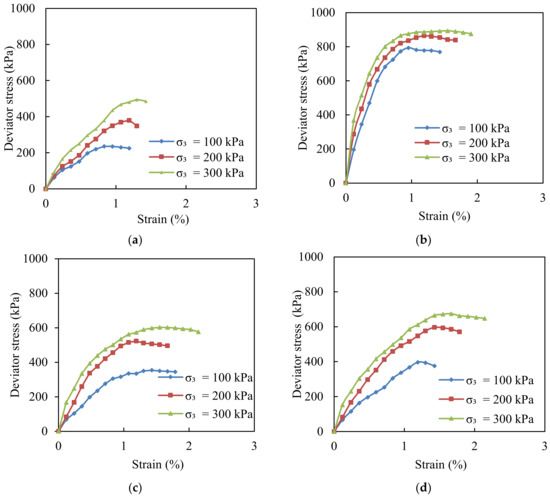
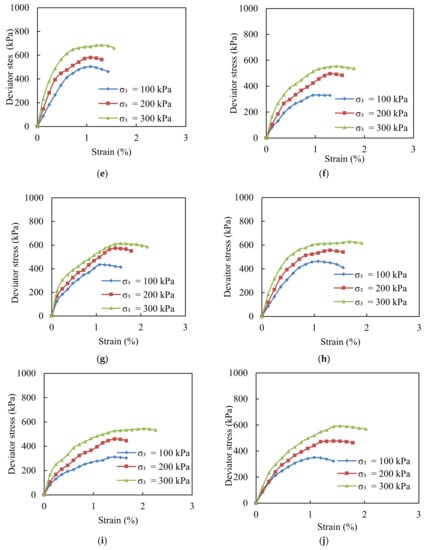
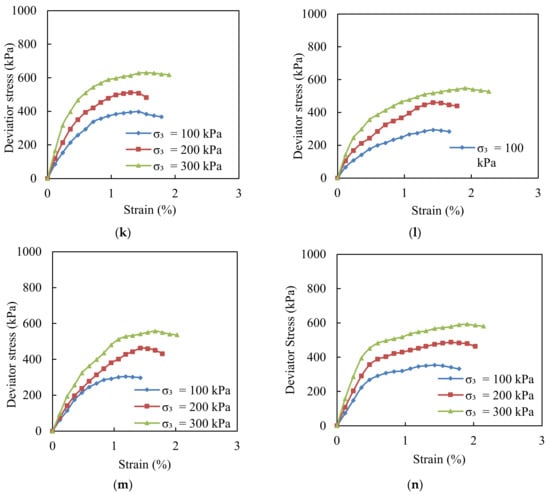
Figure 9.
Deviator stress versus axial strain curves of fly ash, bentonite, and fly ash–bentonite in different ratios with layers. (a) Fly ash. (b) Bentonite. (c) F:B = 1:1, N = 1, F = 2L, B = 1L. (d) F:B = 1:1, N = 2, F = 2L, B = 1L. (e) F:B = 1:1, N = 3, F = 2L, B = 2L. (f) F:B = 2:1, N = 1, F = 1L, B = 1L. (g) F:B = 2:1, N = 2, F = 2L, B = 1L. (h) F:B = 2:1, N = 3, F = 2L, B = 2L. (i) F:B = 3:1, N = 1, F = 1L, B = 1L. (j) F:B = 3:1, N = 2, F = 2L, B = 1L. (k) F:B = 3:1, N = 3, F = 2L, B = 2L. (l) F:B = 4:1, N = 1, F = 1L, B = 1L. (m) F:B = 4:1, N = 2, F = 2L, B = 1L. (n) F:B = 4:1, N = 3, F = 2L, B = 2L.
For F:B = 1:1, the increments in deviator stress for N = 1, 2, and 3 with respect to fly ash are 50, 68.22, and 113.12%, respectively, on confining pressure 100 kPa; 38.42, 57.11, and 52.89% on confining pressure 200 kPa; and 21.62, 36.36, and 38.38% on confining pressure 300 kPa. For F:B = 2:1, the increments in deviator stress for N = 1, 2, and 3 with respect to fly ash are 40.25, 84.32, and 96.61%, respectively, on confining pressure 100 kPa; 30.79, 53.68, and 72.89% on confining pressure 200 kPa; and 12.12, 24.04, and 27.27% on confining pressure 300 kPa. For F:B = 3:1, the increments in deviator stress for N = 1, 2, and 3 with respect to fly ash are 32.20, 48.73, and 68.64%, respectively, on confining pressure 100 kPa; 17.37, 25.79, and 34.74% on confining pressure 200 kPa; and 10.10, 13.13, and 27.27% on confining pressure 300 kPa. For F:B = 4:1, the increments in deviator stress for N = 1, 2, and 3 with respect to fly ash are 24.58, 29.24, and 49.15%, respectively, on confining pressure 100 kPa; 11.32, 21.84, and 28.16% on confining pressure 200 kPa; and 10.71, 12.73, and 19.60% on confining pressure 300 kPa.
4.2. Shear Strength Parameters
The total axial stress results of the series of consolidated undrained triaxial tests at increasing confining pressure were plotted on a Mohr’s circle diagram to evaluate effective shear strength parameters (c and ϕ). A straight line drawn as a tangent to the circles, with the equation τ = c + σ tan ϕ, is used to simulate the condition of the sample’s failure. The angle of shearing resistance (ϕ) is the angle between the tangent and a line parallel to the shear stress, and the value of cohesion (c) is read from the shear stress axis, where it is cut by the tangent to the Mohr’s circles. The values of c and ϕ are summarized in Table 4.

Table 4.
Shear strength parameters of fly ash bentonite in different ratios with layers.
As shown in Figure 10, for a particular ratio of fly ash to bentonite, the value of cohesion increased with the increase in the number of interfaces. When the number of interfaces is equal to one, it was noticed that the value of cohesion continuously decreased as the ratio of fly ash to bentonite was increased. At number of interfaces equal to 2, the value of cohesion decreased when the ratio F:B changed from 1:1 to 2:1. However, when the ratio of F:B became 3:1, the value of cohesion increased before reducing again at F:B = 4:1. At N = 3, it was found that, with increasing ratio of F:B, an increase in value of c was recorded until the ratio was 2:1. At a 3:1 ratio of F:B, the value of cohesion decreased and then fell drastically at F:B ratio = 4:1.
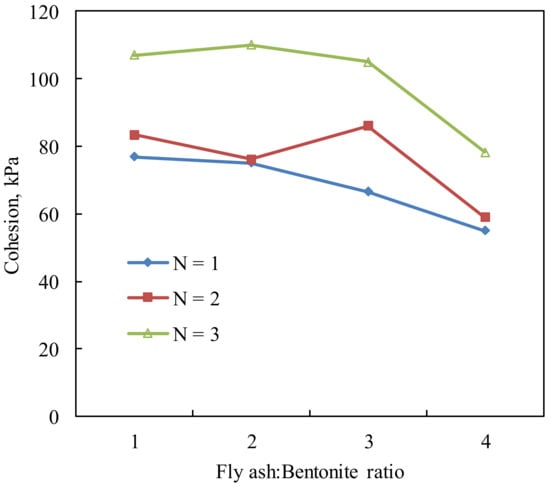
Figure 10.
Effective cohesion values against fly ash–bentonite ratios.
As shown in Figure 11, it was also found that the value of the angle of shear resistance is largest for fly ash. For the same ratio of fly ash to bentonite, it decreases gradually as the number of interfaces was increased. However, the values of ϕ are quite close to each other, i.e., not much drastic change is observed in their response to changing ratios and varying interfaces.
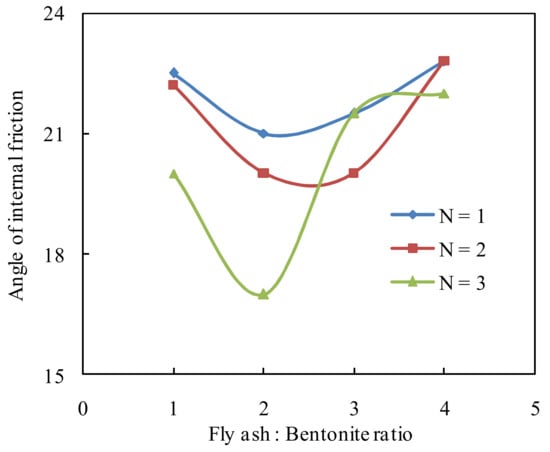
Figure 11.
Effective angle of shear resistance values against fly ash–bentonite ratios.
5. Conclusions
The following conclusions are drawn based on the results of the experimental investigation:
- Fly ash is a nearly cohesionless substance that has a binding effect at the fly ash–bentonite layered system interfaces.
- For F:B = 1:1, 1:2, 1:3, and 1:4, the value of cohesion has been varied in the ranges of 76.8–107 kPa, 75–110 kPa, 66.6–105 kPa, and 55–78.2 kPa, respectively, for different layer arrangements. As the ratio of fly ash to bentonite is increased, the value of cohesion is decreased, while at the same ratio, the value of cohesion is increased by increasing the number of interfaces.
- For F:B = 1:1, 1:2, 1:3, and 1:4, the value of angle of shearing resistance has been varied in the range of 17–22.8° for different layer arrangements. The value of the angle of shearing resistance has been found to decreases with the increase in the number of interfaces for a specified ratio of fly ash to bentonite.
- The stress–strain behaviour of the fly ash–bentonite layered system is initially elastic at low stress levels and becomes non-linear at higher stress levels.
- As the number of interfaces and confining pressures grow, the shear strength and net safe bearing capacity of the fly ash–bentonite layered system increases.
- Based on laboratory model tests, it has been suggested that the embankment may provide greater stability if it is constructed for a fly ash to bentonite ratio of 3:1 (75% of fly ash and 25% of bentonite in layers) by keeping the number of interfaces as N = 3.
- It has been found that a 3:1 ratio of fly ash to bentonite with three interfaces can be successfully used for filling low-lying areas and in many other engineering constructions, while also providing a means of using the material without negatively impacting the environment. However, the authors recommend that large-scale studies be conducted in the future.
Author Contributions
M.H.: drafting—data collection and preparation of the manuscript, writing-review and editing, M.A.K. (Mehboob Anwer Khan): drafting—preparation of the manuscript, revision, and correction; A.H.A.: composing—reviewing and modifying; A.A.A.: composing—reviewing and modifying; S.A.: composing—reviewing and modifying and M.A.K. (Mohammad Amir Khan): composing—reviewing and modifying., T.B. reviewing and modifying, J.P.: reviewing and modifying. All authors have read and agreed to the published version of the manuscript.
Funding
The authors would like to acknowledge the support provided by Researchers Supporting Project Number (RSP2022R473), King Saud University, Riyadh, Saudi Arabia.
Institutional Review Board Statement
Not applicable.
Informed Consent Statement
Not applicable.
Data Availability Statement
Not applicable.
Conflicts of Interest
The authors declare no conflict of interest.
References
- Bhatt, A.; Priyadarshinia, S.; Mohanakrishnana, A.C.; Abria, A.; Sattlera, M.; Techapaphawitc, S. Physical, Chemical, and Geotechnical Properties of Coal Fly Ash: A Global Review. Case Stud. Constr. Mater. 2019, 11, e00486. [Google Scholar] [CrossRef]
- Rajak, T.K.; Yadu, L.; Chouksey, S.K. Effect of fly ash on geotechnical properties and stability of coal mine overburden dump: An overview. Appl. Sci. 2020, 2, 973. [Google Scholar] [CrossRef]
- Lauzurique, Y.; Montalvo, S.; Salazar, R.; García, V.; Huiliñir, C. Fly ash from coal combustion as improver of anaerobic digestion: A review. J. Environ. Chem. Eng. 2021, 9, 106422. [Google Scholar] [CrossRef]
- Mathur, N. Report on Fly Ash Generation at Coal/Lignite Based Thermal Power Stations and its Utilization in the Country for the Year; Ministry of Power, Government of India: New Delhi, India, 2020; p. 110016. [Google Scholar]
- Vittal, G. Bulk utilization of fly ash in construction of road embankments in India. Coal Ash India 2001, 2, 6–7. [Google Scholar]
- Indraratna, B.; Nutalaya, P.; Kuganenthira, N. Stabilization of a dispersive soil by blending with fly ash. Q. J. Eng. Geol. Hydrogeol. 1991, 24, 275–290. [Google Scholar] [CrossRef]
- Sivapullaiah, P.V.; Prashant, J.P.; Sridharan, A. Effect of fly ash on the index properties of BC soil. Soils Found. 1996, 36, 97–103. [Google Scholar] [CrossRef] [Green Version]
- Kaniraj, S.R.; Havanagi, V.G. Behavior of cement-stabilized fiber-reinforced fly ash–soil mixtures. J. Geotech. Geoenviron. Eng. ASCE 2001, 127, 574–584. [Google Scholar] [CrossRef]
- Ghosh, A.; Subbarao, C. Strength Characteristics of Class F Fly ash Modified with Lime and Gypsum. J. Geotech. Geoenvironmental. Eng. 2007, 133, 7. [Google Scholar] [CrossRef]
- Senol, A. Effect of fly ash and polypropylene fibres content on the soft soils. Bull. Eng. Geol. Environ. 2012, 71, 379–387. [Google Scholar] [CrossRef]
- Sivapullaiah, P.V.; Sridharan, A.; Stalin, V.K. Hydraulic conductivity of bentonite-sand mixtures. Can. Geotechn. J. 2000, 37, 406–413. [Google Scholar] [CrossRef]
- Pandian, N.S.; Nagaraj, T.S.; Raju, P.N. Permeability and compressibility behavior of bentonite-sand/soil mixes. Geotechnical. Test. J. 1995, 18, 86–93. [Google Scholar]
- Kashir, M.; Yanful, E.K. Hydraulic conductivity of bentonite permeated with acid mine drainage. Can. Geotech. J. 2001, 38, 1034–1048. [Google Scholar] [CrossRef]
- Sivapullaiah, P.V.; Lakshmikantha, H. Properties of Fly ash as Hydraulic Barrier. Soil Sediment. Contam. 2004, 13, 489–504. [Google Scholar] [CrossRef]
- Younus, M.M.; Sreedeep, S. Evaluation of Bentonite-Fly ash Mix for Its Application in Landfill Liners. J. Test. Eval. 2012, 40, 40–49. [Google Scholar] [CrossRef]
- Mollamahmutoglu, M.; Yilmaz, Y. Potential Use of Fly ash and Bentonite Mixture as Liner or Cover at Waste Disposal Areas. Environ. Geol. 2001, 40, 1316–1324. [Google Scholar] [CrossRef]
- Garg, A.; Reddy, N.G.; Huang, H. Modelling contaminant transport in fly ash–bentonite composite landfill liner: Mechanism of different types of ions. Sci. Rep. 2020, 10, 11330. [Google Scholar] [CrossRef] [PubMed]
- Wasil, M. Effect of Bentonite Addition on the Properties of Fly Ash as a Material for Landfill Sealing Layers. Appl. Sci. 2020, 10, 1488. [Google Scholar] [CrossRef] [Green Version]
- ASTM C 618; Standard Specification for Coal Fly Ash and Raw or Calcined Natural Pozzolan for Use in Concrete. American Society for Testing and Materials: Philadelphia, PA, USA, 2019.
- Zabielska-Adamska, K. Characteristics of Compacted Fly Ash as a Transitional Soil. Materials 2020, 13, 1387. [Google Scholar] [CrossRef] [PubMed] [Green Version]
- IS: 2720-Part 3; Methods of Test for Soils: Determination of Specific Gravity, Section 1 Fine Grained Soils. Indian Standards Institution: New Delhi, India, 1980.
- IS: 2720-Part 4; Methods of Test for Soils: Grain Size Analysis. Indian Standards Institution: New Delhi, India, 1985.
- IS: 2720-Part 5; Code of Practice for Determination of Liquid Limit and Plastic Limit. Indian Standards Institution: New Delhi, India, 1985.
- IS: 2720-Part 10; Methods of Test for Soils: Determination of Unconfined Compressive Strength. Indian Standards Institution: New Delhi, India, 1991.
Publisher’s Note: MDPI stays neutral with regard to jurisdictional claims in published maps and institutional affiliations. |
© 2022 by the authors. Licensee MDPI, Basel, Switzerland. This article is an open access article distributed under the terms and conditions of the Creative Commons Attribution (CC BY) license (https://creativecommons.org/licenses/by/4.0/).